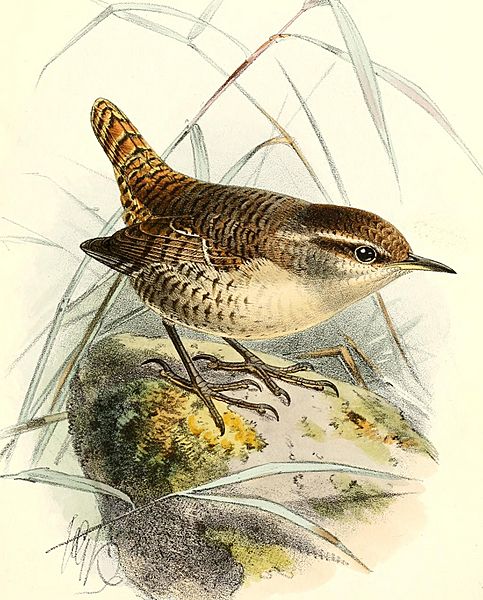Image: Ibis (1885) (14565465039)

Description: St. Kilda Wren - Troglodytes troglodytes hirtensis Identifier: ibis35brit (find matches) Title: Ibis Year: 1859 (1850s) Authors: British Ornithologists' Union Subjects: Birds -- Periodicals Publisher: (London) Published for the British Ornithologists' Union by Academic Press Contributing Library: American Museum of Natural History Library Digitizing Sponsor: Biodiversity Heritage Library View Book Page: Book Viewer About This Book: Catalog Entry View All Images: All Images From Book Click here to view book online to see this illustration in context in a browseable online version of this book. Text Appearing Before Image: ht here many years ago, which, from his description, Itook to be the Barn-Owl. TURDUS MUSICUS. I include the Song-Thrush as a bird of St. Kilda on theauthority of Sir William Milner. It probably occurs onmigration. TuRDus TLiAcus. Smcorach. The Redwing is seen on St. Kilda during its annualmigration, in May and September, in flocks. Merula merula. Lon-dutha. The Blackbird visits St. Kilda on spring and autumnmigration, but never remains to breed. Saxicola (ENANTHE. Clacharau. The Wheatear is very common on St. Kilda, and is one ofthe most conspicuous land-birds as it flies to and fro overthe stony hillsides. I did not observe it on Doon. Troglodytes hirtensis, Seebohm. (Plate III.)The most interesting result of my trip to St. Kilda was thedetermination of its Wren, called Dhra-in-doun by thenatives. Although this little Wren was known to Martinnearly two hundred years ago, neither he nor any subse-quent naturalist had the least idea that the bird was difierent Itis 1885.pl m. ^^^.. /% Text Appearing After Image: J - & ,Keule:m.Eais Jit Ja. TROGLODYTES HIRTENSIS Hanhcurt imp OrmtJioIogij of St. Kilda. 81 from the Wren iuliabitiug the rest of the United Kingdom.This little stranger was introduced to the notice of ornitho-logists by Mr. Seebohm (Zoologist/ 1884, p. 333). Hewrites :—^ The St,-Kilda Wren most nearly resembles Tro-glodytes parvuJus pallescens from the Western AleutianIslands, but is much more distinctly barred on the back andhead, and almost free from any traces of spots on the throatand breast. In general colour it is quite as pale and slightlygreyer than examples of Troglodytes parvulus pallidus fromAlgeria and Turkestan. The bill resembles that of Troglo-dytes parvulus borealis from the Faroe Islands. The eye-stripe is as distinct as in typical examples from Europe, acharacter which is least developed in T. parvulus nipalensisand T. j)arvulus fumigatus. I had not been on St. Kilda long before the little birdarrested my attention, as it flew from rock to rock, or glidedin a Note About Images Please note that these images are extracted from scanned page images that may have been digitally enhanced for readability - coloration and appearance of these illustrations may not perfectly resemble the original work.
Title: Ibis (1885) (14565465039)
Credit: https://www.flickr.com/photos/internetarchivebookimages/14565465039/ Source book page: https://archive.org/stream/ibis35brit/ibis35brit#page/n112/mode/1up
Author: Creator:John Gerrard Keulemans
Permission: At the time of upload, the image license was automatically confirmed using the Flickr API. For more information see Flickr API detail.
Usage Terms: No known copyright restrictions
License: No restrictions
License Link: https://www.flickr.com/commons/usage/
Attribution Required?: No
Image usage
The following page links to this image:

